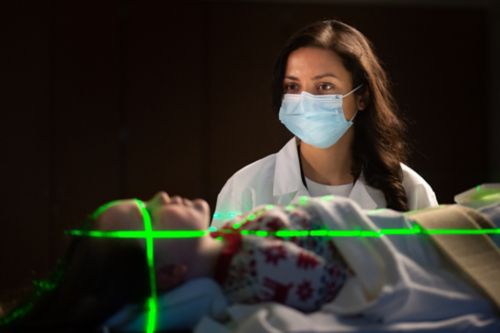These tests give doctors a wealth of information to help diagnose and treat illnesses. It is a way for physicians to look at a 3D image of inside the body. For example, doctors can use these images to find cancer.
CT images of organs, bones, tissue, and blood vessels are more detailed than X-rays.
You should always feel comfortable asking your child’s care team questions.
If you’re concerned about radiation from a test or scan, ask. Sometimes there is an alternative test. In other cases, choosing a CT scan might be the best option.
Here’s an example:
If your child’s care team needs an image of a certain part of the body, starting with the CT scan can sometimes ensure they receive less radiation and fewer tests.
That’s because an X-ray may not show what the team needs to see. It’s possible your child might need a CT scan regardless.
Imaging tests and genetic cancer predispositions
If your child has a genetic cancer predisposition like Li-Fraumeni syndrome (LFS) or DICER1 syndrome, then you may have more questions for your doctor. It’s important that everyone on your child’s care team knows your child has one of these conditions.
For example, LFS can put you at an increased risk for radiation-associated cancers. So, your child’s care team will want to limit scans and tests when it’s possible.
Questions to ask your child’s doctor
Here are some questions to ask your child’s care team if you’re concerned about radiation exposure:
- Why is the test needed?
- Will the results change the treatment decisions?
- Is there an alternative test that doesn’t involve radiation?
- Should I be worried about my child's fertility after imaging tests?
ALARA guidelines
ALARA stands for “As Low As Reasonably Achievable.” Radiologists, nuclear medicine specialists, and other providers use it to guide radiation doses for patients. The basic principle is that if receiving the radiation dosage has no benefit, you should avoid it.
Care team members use three guidelines to ensure that radiation doses are small, that it is used only when necessary, and that others in the room are protected:
- Time – Spend as little time as possible near the radiation source.
- Distance – Stay as far away from the radiation source as possible.
- Shielding – Put something between yourself and the source. The vests care team members wear are an example of shielding.
Current guidelines don’t recommend shielding patients, but parents in the room and team members should shield. If you have questions about shielding, talk with your child’s care team.
In the past, care team members would have used lead shields to protect sex organs or to protect a fetus in a pregnant patient. Studies show that shielding does not help and might cause other problems. So, care teams do not always use lead shields during x-rays.
The American College of Radiology and the American Association of Physicists in Medicine strive to make tests as safe as possible. Both groups recommend no shield for sex organs during an x-ray.

